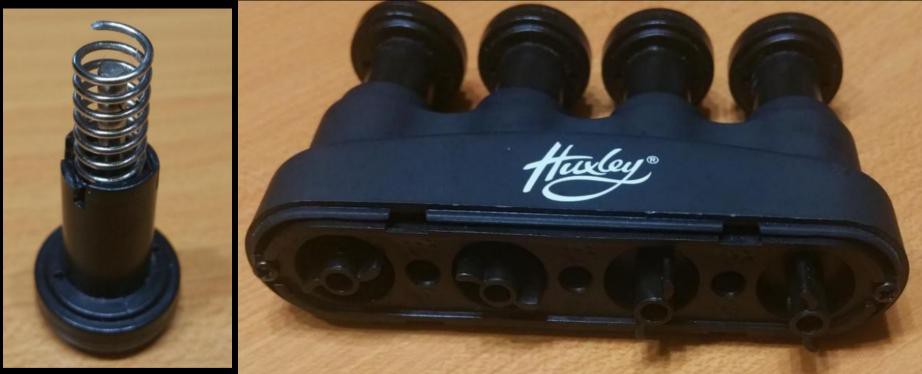I occasionally play guitar, and when I'm not on the guitar I'm probably eating or on a computer. I bought a guitarist finger exerciser a while ago for about $5 in a music shop, that seemed useful to reduce RSI / Carpal Tunnel syndrome.
One day I was on the couch watching Netflix on my TV-connected laptop, with a mini keyboard + trackpad on my lap and my finger exerciser in the other hand, and I thought: can I measure these finger squeezes and use it to control my computer? Surely I can measure something, either a digital open/closed signal or possibly even an analog distance. When I opened up the exerciser I saw that each finger is made with a thin metal pole that's surrounded by a metal spring, that presses against the plastic surroundings.

The metal spring is the part that strengthens your finger muscles, and the metal pole would be to make sure it only moves straight along the axis.
When you squeeze a finger, the metal pole comes closer to the end of the tiny plastic cylinder, but it stays inside. So I tried finding a surface-mount Infrared LED and optical sensor that is tiny enough to send a reflection into the hole and measure the reflectance. But I realized it's such a small hole (around 3mm diameter) that it would be very tough to get it to work, and it would have a relatively large amount of electronics on the end to fit all the parts, so it might become a little uncomfortable to hold, but it probably could be done with some effort.
Then I thought that maybe I'm lucky and the metal pole is magnetic and the metal spring isn't, and then I'd possibly be able to measure the metal pole using a magnetic sensor. I didn't have enough experience with magnets and magnetic sensors to know if I'd need an ultra sensitive sensor or a fairly weak sensor, or whether the pole was magnetic at all.
So I decided to read the spec sheet of roughly 20 different types of magnetic sensors, until I realized that while many of these sensors measure a yes/no presence of a magnet, or they measure a changing amount of magnetism (such as an electric guitar pickup), I want a magnetic sensor that measures a stationary magnet and the sensor sends an analog output. Luckily I found a sensor that does this and comes in multiple sensitivity ranges. I still wasn't sure if the metal pole is magnetic or if I need to glue a weak magnet or a strong magnet to the end of the pole. I also didn't know if the magnetism of one finger would interfere with the other sensors, since each finger is quite close apart. So I decided to buy several tiny SMD magnetic sensors of low, medium and high sensitivity, as well as several tiny magnets of low, medium and high strength. I figured there has to be some combination that works pretty well!
 Shervin Emami
Shervin Emami
Discussions
Become a Hackaday.io Member
Create an account to leave a comment. Already have an account? Log In.